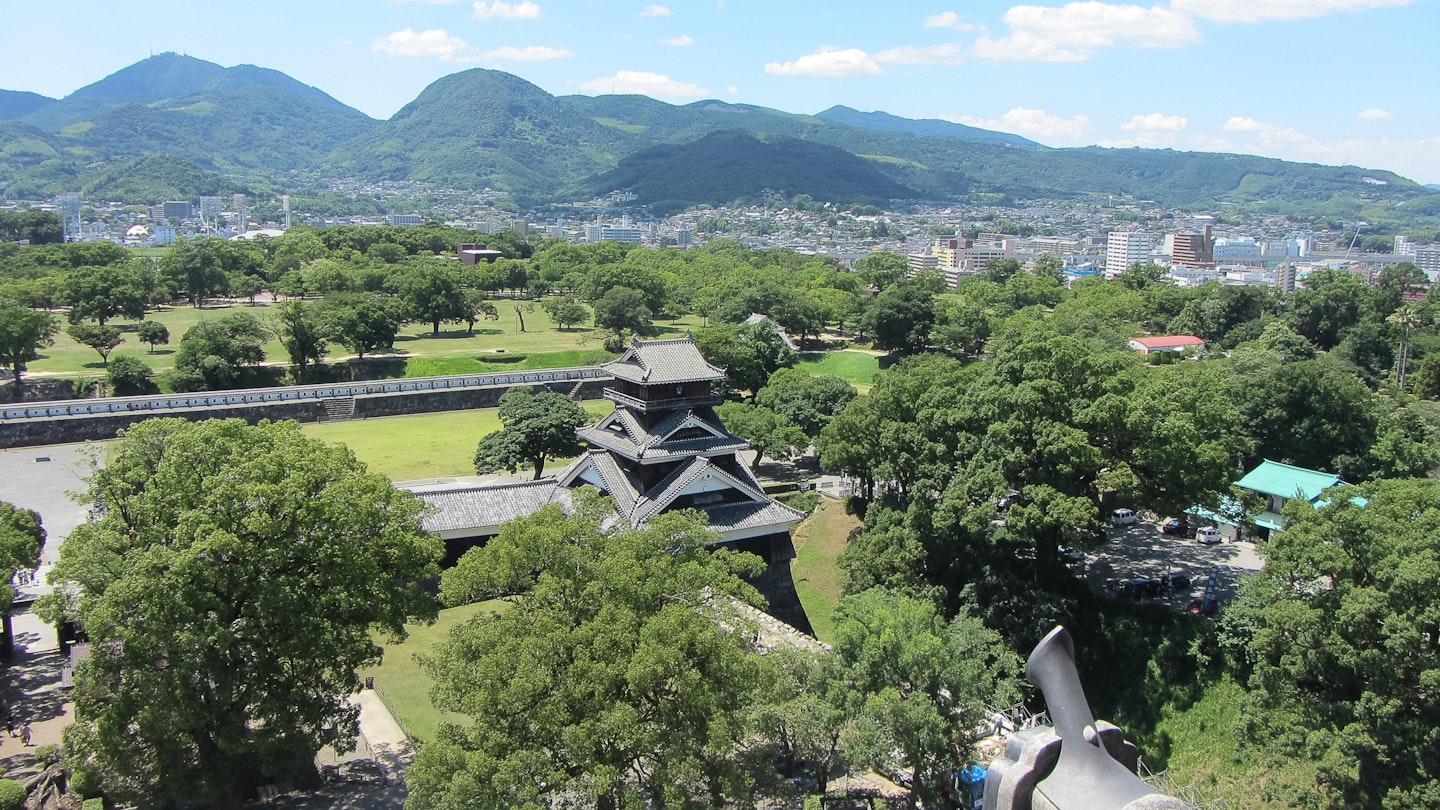Explore Kumamoto: A Fusion of History, Culture, and Nature
Kumamoto is a modern Japanese city located in the west-central region of Kyushu. Proud of its roots as a medieval castle town (jokamachi), it serves as an ideal destination for those interested in Japan’s cultural traditions. Moreover, Kumamoto is a convenient base for exploring the wealth of natural wonders nearby, including Mt. Aso, one of Japan’s most active volcanoes.
Kumamoto Castle: The Beating Heart of the City
In April 2016, Kumamoto Castle made headlines worldwide as video footage captured its 400-year-old stone walls crumbling due to a major earthquake. All thirteen buildings of this national important cultural property suffered damage or destruction.
However, within weeks, the city initiated restoration efforts to shore up the beloved castle. Full restoration is projected to take another 15 years, but Kumamoto Castle has already re-opened certain sections to visitors. Catwalks now provide access to limited areas where visitors can view both the damage and the ongoing restoration work. As restoration progresses, additional buildings will also re-open.
The castle’s keep, recognized for its distinctive two towers, opened to the public in summer 2021. Inside, a museum presents information about the castle’s history. Visitors will learn about the feudal warlord Kiyomasa Kato (1562-1611), who designed the castle to be impregnable, featuring steep stone walls that reach up to 20 meters high and an extensive water supply system with around 120 deep wells.
According to legend, Kiyomasa also planted ginkgo trees around the castle for emergency food supply during sieges. One of these ancient trees now stands tall in front of the keep, exhibiting stunning golden leaves in autumn.
A visit to the top floor of the keep grants panoramic views of the city and surrounding countryside. On clear days, visitors may witness smoke rising from the Mt. Aso volcano, located approximately 50km to the east.
Japan celebrates its changing seasons, and Kumamoto Castle provides an excellent vantage point for experiencing the vibrant autumn leaves and scenic spring blossoms. The castle grounds attract numerous visitors during cherry blossom season, when around 800 cherry trees cloak the landscape in delicate pink, contrasting beautifully with the black castle keep.
Experience Traditional Crafts
Over the centuries, artisans in Japan’s castle towns developed traditional crafts to satisfy their feudal lords. One notable craft is damascene, known as Higo Zogan in Japanese. This intricate art form uses inlaid gold and silver designs, historically adorning sword and gun handles for samurai warriors. Today, Higo Zogan primarily decorates jewelry and personal items, such as pens and hand mirrors.
In the Shinmachi district, just below the castle, visitors can participate in a workshop at Mitsusuke. Fourth-generation artisan Yuji Osumi guides participants through the experience of pounding gold leaf onto a black iron base, which eventually transforms into a key fob or pendant. Each participant can complete a basic pattern in under an hour, with Osumi finishing and mailing the item back, making for a memorable souvenir of Kumamoto. The cost is approximately 3,500 yen (about $35 USD).
Suizenji Jojuen Garden
The feudal lords of Kumamoto Castle appreciated the finer things in life, a love reflected in the design of Suizenji Jojuen Garden, located a short drive from the castle. This traditional strolling garden features a spring-fed pond and remains a serene location for walking.
The garden includes two Shinto shrines, a horseback archery course, and a Noh stage showcasing traditional Japanese masked drama. At a thatched tea house overlooking the pond, visitors can sip traditional green tea while enjoying sweet treats, evoking a sense of relaxation reminiscent of feudal lords from centuries past.
A striking miniature of Mt. Fuji serves as the centerpiece of the landscape, harkening back to the original design that emulated the famous Tokaido Road’s 53 stages between Kyoto and Edo (now Tokyo), with Mt. Fuji as the most iconic sight for travelers.
Experiencing the Way of the Warrior
The legacy of Musashi Miyamoto (1584-1645), Japan’s legendary swordsman, looms large in Kumamoto, where he once taught his skills to local warriors. His influential writings, encapsulated in The Book of Five Rings, continue to inspire martial arts practitioners today.
Through Meihodo—a retreat facility inside the Aso Caldera—visitors can learn traditional warrior arts, including kendo and judo, as well as engage in tea ceremonies and flower arranging. Participants can enjoy half-day experiences mastering the art of wielding a Japanese sword and even practice making a diagonal slice through bamboo.
For those seeking an extended experience, overnight stays are available in traditional-styled buildings and gardens, including opportunities to try misogi, a cleansing ritual involving standing under an icy waterfall, embodying Japan’s nature worship traditions.
Eco-friendly Sightseeing Around Mt. Aso
The Meihodo complex integrates its buildings harmoniously with nature, exemplifying centuries of architectural design. The surrounding area of Mt. Aso, a UNESCO Geopark, offers abundant eco-friendly experiences in its stunning natural landscapes, including hiking and horseback riding trails through the caldera’s volcanic peaks and rims. Guides are available for those who prefer expert navigation.
One enjoyable way to experience the geology of the Aso caldera up close is through a bicycle tour around the northern rim. Aso Kuju Cycle Tour offers various distance and difficulty levels, led by knowledgeable guides like Kota Hashimoto, who ensures fun while highlighting the area’s history and geology. Pricing depends on the selected tour length.
After a day of exploring the Aso caldera’s natural wonders, rejuvenate in a hot spring (onsen). The volcanic activity in the region has created numerous onsens, each with different mineral contents and medicinal properties, providing a relaxing retreat for visitors.
Kumamoto serves as a gateway to the natural beauty and cultural richness of Japan, making it the perfect location to explore and experience the heart of the nation.





